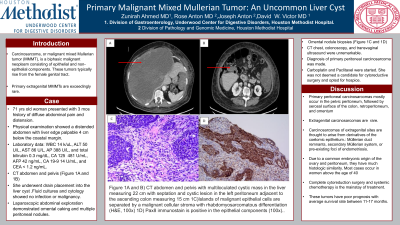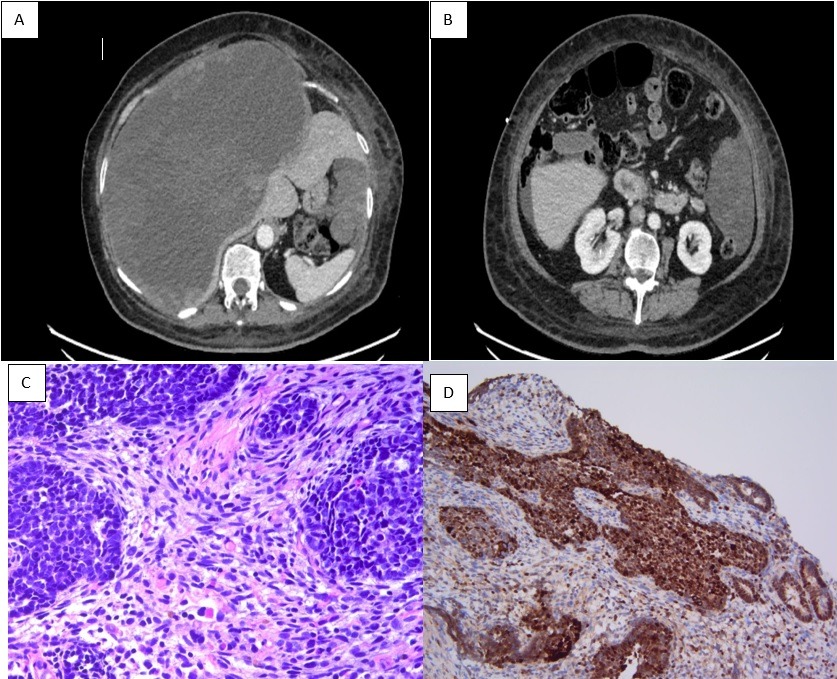Back


Poster Session B - Monday Morning
Category: Liver
B0569 - Primary Malignant Mixed Mullerian Tumor: An Uncommon Liver Cyst
Monday, October 24, 2022
10:00 AM – 12:00 PM ET
Location: Crown Ballroom

Has Audio
.jpg)
Zunirah Ahmed, MD
Houston Methodist Hospital
Houston, TX
Presenting Author(s)
Zunirah Ahmed, MD, Rose Anton, MD, Joseph Anton, , David Victor, MD
Houston Methodist Hospital, Houston, TX
Introduction: Carcinosarcoma, or malignant mixed Mullerian tumor (MMMT), is a biphasic malignant neoplasm consisting of epithelial and non-epithelial components.These tumors typically rise from the female genital tract.Primary extragenital MMMTs are exceedingly rare.
Case Description/Methods: 71 yrs old woman presented with 3-month history of diffuse abdominal pain associated with abdominal distension and lower extremity edema.Other history was unremarkable.Physical examination showed a distended abdomen with liver edge palpable 4 cm below the coastal margin and edema in lower extremities.Laboratory data showed WBC 14 k/uL, ALT 50 U/L, AST 86 U/L, AP 388 U/L, and total bilirubin 0.3 mg/dL.CT abdomen and pelvis demonstrated a multiloculated cystic mass in the liver measuring 22 cm with septation, cystic lesion in the left peritoneum adjacent to the ascending colon measuring 15 cm, and a peritoneal nodule near the umbilicus measuring 3.5 cm (Figure 1A , B).CA 125 was 481 U/mL, AFP 42 ng/mL, CA 19-9 14 U/mL, and CEA < 1.2 ng/mL.She underwent drain placement into the liver cyst.Fluid cultures and cytology showed no infection or malignancy.Laparoscopic abdominal exploration was performed which demonstrated omental caking and multiple peritoneal nodules.Omental nodule biopsies showed carcinosarcoma composed of high-grade epithelial and mesenchymal components, with areas of rhabdomyosarcomatous differentiation (1C).Immunohistochemical staining favored Mullerian origin (1D). CT chest, colonoscopy, and transvaginal ultrasound were unremarkable. Diagnosis of primary peritoneal carcinosarcoma was made and carboplatin and paclitaxel were started. Her hospital course was complicated with extensive left lower extremity DVT.She was not deemed a candidate for cytoreductive surgery and opted for hospice.
Discussion: Primary peritoneal carcinosarcomas mostly occur in the pelvic peritoneum, followed by serosal surface of the colon, retroperitoneum, and omentum.Extragenital carcinosarcomas are very rare. Carcinosarcomas of extragenital sites are thought to arise from Müllerian duct remnants, secondary Müllerian system, or pre-existing foci of endometriosis, all of which are derivatives of the coelomic epithelium. Due to a common embryonic origin of the ovary and peritoneum, they have much histologic similarity. Most cases occur in women above the age of 40. Complete cytoreduction surgery and systemic chemotherapy is the mainstay of treatment.These tumors have poor prognosis with average survival rate between 11-17 months.

Disclosures:
Zunirah Ahmed, MD, Rose Anton, MD, Joseph Anton, , David Victor, MD. B0569 - Primary Malignant Mixed Mullerian Tumor: An Uncommon Liver Cyst, ACG 2022 Annual Scientific Meeting Abstracts. Charlotte, NC: American College of Gastroenterology.
Houston Methodist Hospital, Houston, TX
Introduction: Carcinosarcoma, or malignant mixed Mullerian tumor (MMMT), is a biphasic malignant neoplasm consisting of epithelial and non-epithelial components.These tumors typically rise from the female genital tract.Primary extragenital MMMTs are exceedingly rare.
Case Description/Methods: 71 yrs old woman presented with 3-month history of diffuse abdominal pain associated with abdominal distension and lower extremity edema.Other history was unremarkable.Physical examination showed a distended abdomen with liver edge palpable 4 cm below the coastal margin and edema in lower extremities.Laboratory data showed WBC 14 k/uL, ALT 50 U/L, AST 86 U/L, AP 388 U/L, and total bilirubin 0.3 mg/dL.CT abdomen and pelvis demonstrated a multiloculated cystic mass in the liver measuring 22 cm with septation, cystic lesion in the left peritoneum adjacent to the ascending colon measuring 15 cm, and a peritoneal nodule near the umbilicus measuring 3.5 cm (Figure 1A , B).CA 125 was 481 U/mL, AFP 42 ng/mL, CA 19-9 14 U/mL, and CEA < 1.2 ng/mL.She underwent drain placement into the liver cyst.Fluid cultures and cytology showed no infection or malignancy.Laparoscopic abdominal exploration was performed which demonstrated omental caking and multiple peritoneal nodules.Omental nodule biopsies showed carcinosarcoma composed of high-grade epithelial and mesenchymal components, with areas of rhabdomyosarcomatous differentiation (1C).Immunohistochemical staining favored Mullerian origin (1D). CT chest, colonoscopy, and transvaginal ultrasound were unremarkable. Diagnosis of primary peritoneal carcinosarcoma was made and carboplatin and paclitaxel were started. Her hospital course was complicated with extensive left lower extremity DVT.She was not deemed a candidate for cytoreductive surgery and opted for hospice.
Discussion: Primary peritoneal carcinosarcomas mostly occur in the pelvic peritoneum, followed by serosal surface of the colon, retroperitoneum, and omentum.Extragenital carcinosarcomas are very rare. Carcinosarcomas of extragenital sites are thought to arise from Müllerian duct remnants, secondary Müllerian system, or pre-existing foci of endometriosis, all of which are derivatives of the coelomic epithelium. Due to a common embryonic origin of the ovary and peritoneum, they have much histologic similarity. Most cases occur in women above the age of 40. Complete cytoreduction surgery and systemic chemotherapy is the mainstay of treatment.These tumors have poor prognosis with average survival rate between 11-17 months.

Figure: Figure 1A and B) CT abdomen and pelvis with multiloculated cystic mass in the liver measuring 22 cm with septation and cystic lesion in the left peritoneum adjacent to the ascending colon measuring 15 cm 1C)Islands of malignant epithelial cells are separated by a malignant cellular stroma with rhabdomyosarcomatous differentiation (H&E, 100x) 1D) Pax8 immunostain is positive in the epithelial components (100x).
Disclosures:
Zunirah Ahmed indicated no relevant financial relationships.
Rose Anton indicated no relevant financial relationships.
Joseph Anton indicated no relevant financial relationships.
David Victor indicated no relevant financial relationships.
Zunirah Ahmed, MD, Rose Anton, MD, Joseph Anton, , David Victor, MD. B0569 - Primary Malignant Mixed Mullerian Tumor: An Uncommon Liver Cyst, ACG 2022 Annual Scientific Meeting Abstracts. Charlotte, NC: American College of Gastroenterology.
